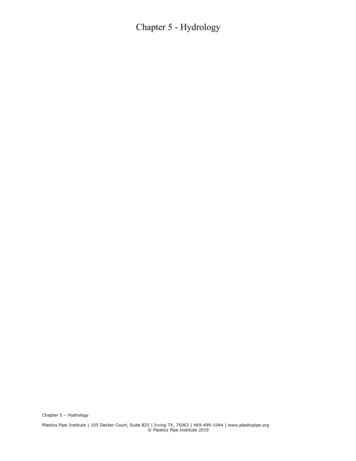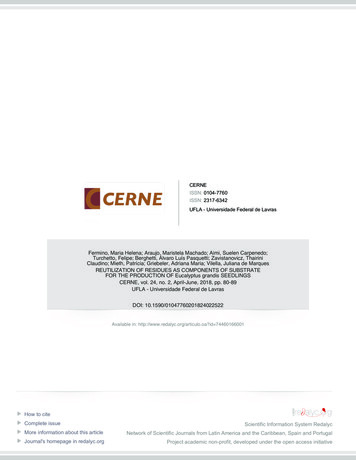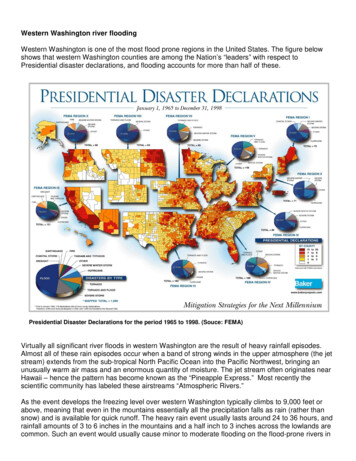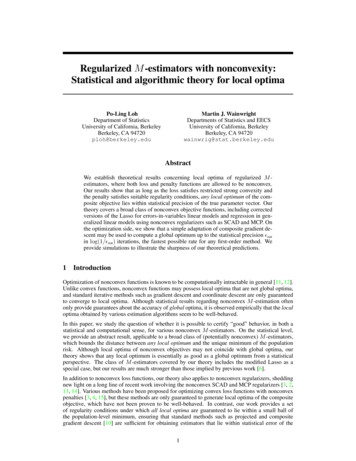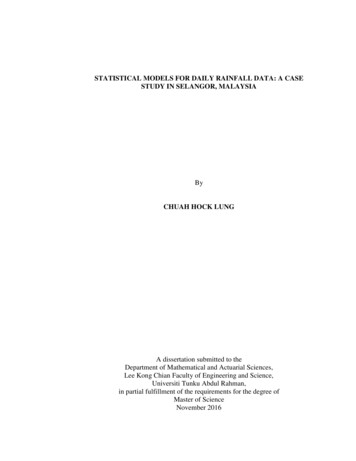
Transcription
STATISTICAL MODELS FOR DAILY RAINFALL DATA: A CASESTUDY IN SELANGOR, MALAYSIAByCHUAH HOCK LUNGA dissertation submitted to theDepartment of Mathematical and Actuarial Sciences,Lee Kong Chian Faculty of Engineering and Science,Universiti Tunku Abdul Rahman,in partial fulfillment of the requirements for the degree ofMaster of ScienceNovember 2016
ABSTRACTSTATISTICAL MODELS FOR DAILY RAINFALL DATA: A CASESTUDY IN SELANGOR, MALAYSIAChuah Hock LungRainfall volume and occurrence analysis is one of the most commonlyapplied methods in rainfall data, while probability distributions such as Normal,Log-normal, Gamma, Gumbel and Weibull are among the importantdistributions that are commonly used in the rainfall analysis. In this study, thedaily rainfall volume for a period of 10 years is investigated and fitted usingvarious continuous distributions. The candidate distributions are selected fromcontinuous distribution and beta related distributions. In addition, the analysisof distributions on rainfall occurrence is investigated and it is fitted to the dailyrainfall data for the same 10 years period. The candidate distributions areHurwitz-Lerch Zeta distribution, Eggenberger-Polya distribution, logarithmicdistribution, truncated Poisson distribution and geometric distribution. Threenew distributions are proposed in this research: the new generalized betadistribution, modified beta distribution and mixture of 2 modified lognormaldistributions. The parameters of the distributions are estimated using themaximum likelihood estimation method; with the help of simulated annealingii
optimization method. The distributions are then plotted and compared to thehistogram of daily rainfall volume and occurrence. Model selection techniquessuch as AIC and BIC are employed to examine the fittings of those distributions.iii
ACKNOWLEDGEMENTFirst and foremost, I would like to express my greatest gratitude to my cosupervisor, Professor Dr. Kunio Shimizu, who has continually given me guidanceon my research. His continuous support, patient, enthusiasm and motivation haveundoubtedly helped me in overcoming many challenges. I am touched by ProfessorShimizu’s effort in sparing much time with me whenever he visits Malaysia,especially when he flew to Malaysia solely to attend my work completion seminarto give me support.Secondly, my deepest appreciation goes to my former supervisor, Dr. ChuaKuan Chin. I would not have begun this study nor would I have completed it ifwithout him. He has shown me his full support and guidance, particularly when Ifirst commenced my research and was an amateurin the area of research. Hisguidance was not just confined to academic matters, but spiritual matters as well.I am also immensely grateful to my current supervisor, Dr. Lee Min Cherngfor his comments on an earlier version of the manuscript. He spared much of histime in understanding and improving my dissertation. Without his supervision andconstant help this dissertation would not have been possible.Last but not least, I would like to thank my parents, especially my latemother who showed me endless support, love and prayers.iv
APPROVAL SHEETThis dissertation entitled “STATISTICAL MODELS FOR DAILY RAINFALLDATA: A CASE STUDY IN SELANGOR, MALAYSIA” was prepared byCHUAH HOCK LUNG and submitted as partial fulfillment of the requirements forthe degree of Master of Science at Universiti Tunku Abdul Rahman.Approved by:01/11/2016(Dr. Lee Min Cherng)Date: .Assistant Professor/SupervisorDepartment of Mathematical and Actuarial SciencesLee Kong Chian Faculty of Engineering and ScienceUniversiti Tunku Abdul Rahman(Professor Dr. Kunio Shimizu)Date: .Professor/Co-supervisorSchool of Statistical ThinkingThe Institute of Statistical Mathematics, Tokyov
LEE KONG CHIAN FACULTY OF ENGINEERING AND SCIENCEUNIVERSITI TUNKU ABDUL RAHMANDate: 01 NOVEMBER 2016SUBMISSION OF DISSERTATIONIt is hereby certified that Chuah Hock Lung (ID No: 12UEM01371)has completed this dissertation entitled “STATISTICAL MODELS FOR DAILYRAINFALL DATA: A CASE STUDY IN SELANGOR, MALAYSIA” under thesupervision of Dr. Lee Min Cherng (Supervisor) from the Department ofMathematical and Actuarial Sciences, Lee Kong Chian Faculty of Engineering andScience, and Professor Dr. Kunio Shimizu (Co-Supervisor) from the School ofStatistical Thinking, The Institute of Statistical Mathematics, Tokyo.I understand that University will upload softcopy of my dissertation in PDF formatinto UTAR Institutional Repository, which may be made accessible to UTARcommunity and public.Yours truly,(Chuah Hock Lung)vi
DECLARATIONI, Chuah Hock Lung hereby declare that the dissertation is based on myoriginal work except for quotations and citations which have been dulyacknowledged. I also declare that it has not been previously or concurrentlysubmitted for any other degree at UTAR or other institutions.(CHUAH HOCK LUNG)Date 01 NOVEMBER 2016vii
TABLE OF CONTENTSPageABSTRACTiiACKNOWLEDGEMENTSivAPPROVAL SHEETvSUBMISSION SHEETviDECLARATIONviiLIST OF TABLESxLIST OF FIGURESxiiLIST OF RE REVIEW2.1 Background2.2 Climate change and rainfall trend2.3 Analysis of rainfall distribution in Malaysia2.4 Modelling of rainfall volume2.4.1 Continuous distribution122.4.2 Continuous distribution: beta-type2.5 Modelling of rainfall occurrence- discrete distribution778911PROPOSED NEW DISTRIBUTIONS3.1 Background3.2 Proposed generalized beta distribution3.2.1 Gauss hypergeometric3.2.2 Generalized beta of the 1st kinddistribution3.2.3 Kumaraswamy distribution3.2.4 Standard arcsine distribution3.3 Proposed modified beta distribution3.4 Proposed mixture of 2 modified lognormal distributions27272830313.0viii172232333435
4.0DATA AND METHODOLOGY4.1 Data collection and statistics (with maps)4.2 Parameter estimation4.3 Model selection criteria4.4 Research procedures39394245465.0RESULTS AND DISCUSSION5.1 Overview5.2 Results on daily rainfall volume modelling5.2.1 Graphs of histogram and probabilitydensity function5.2.2 Discussion on daily rainfall volumemodelling5.2.3 Change of rainfall pattern within studyperiod5.3 Results on rainfall occurrence modelling5.3.1 Graphs of histogram and probabilitymass function5.3.2 Discussion on rainfall occurrencemodelling47474851CONCLUSION AND FUTURE WORK92LIST OF REFERENCES956.0ix6566698090
LIST OF TABLESTablePage2.1Properties of exponential distribution132.2Properties of mixture of 2 exponential distributions132.3Properties of lognormal distribution142.4Properties of mixture of 2 lognormal distributions142.5Properties of modified lognormal distribution152.6Properties of Pareto distribution152.7Properties of marginal of linear and angular distribution162.8Properties of gamma distribution172.9Properties of beta distribution192.10Properties of Gauss hypergeometric distribution202.11Properties of generalized beta of the 1st kind distribution212.12Properties of Kumaraswamy distribution212.13Properties of standard arcsine distribution222.14Properties of Hurwitz-Lerch Zeta distribution242.15Properties of Eggenberger-Polya distribution242.16Properties of logarithmic distribution252.17Properties of truncated Poisson distribution252.18Properties of geometric distribution263.1Values of parameters for proposed generalized beta distribution293.2Properties of modified beta distribution34x
3.3Parameter values for mixture of 2 modified lognormaldistributions374.1Renamed rainfall station405.1Comparison of AIC & BIC for different distributions485.2.1Result of the goodness of fit-test at station A (Dry Spells)705.2.2Result of the goodness of fit-test at station A (Wet Spells)715.3.1Result of the goodness of fit-test at station B (Dry Spells)715.3.2Result of the goodness of fit-test at station B (Wet Spells)725.4.1Result of the goodness of fit-test at station C (Dry Spells)735.4.2Result of the goodness of fit-test at station C (Wet Spells)745.5.1Result of the goodness of fit-test at station D (Dry Spells)745.5.2Result of the goodness of fit-test at station D (Wet Spells)755.6.1Result of the goodness of fit-test at station E (Dry Spells)765.6.2Result of the goodness of fit-test at station E (Wet Spells)775.7.1Result of the goodness of fit-test at station F (Dry Spells)775.7.2Result of the goodness of fit-test at station F (Wet Spells)78Summary of best fit distributions795.8xi
LIST OF FIGURESFiguresPage1.1Map of Malaysia13.1PDF of the proposed generalized beta density293.2PDF of mixture of 2 modified lognormal distributions withdifference parameter values373.3Relationship chart of various distributions384.1The map location for chosen rainfall station in Selangor, Malaysia394.2Relative frequency vs. rainfall volume (mm)414.3Relative frequency vs. dry spell days424.4Relative frequency vs. wet spell days425.1Graph of AIC for different distributions505.2Graph of BIC for different distributions505.3PDF of beta distribution and histogram for rainfall amount525.4PDF of Gauss hypergeometric distribution and histogram forrainfall amount535.5PDF of generalized beta of the 1st kind distribution and histogramfor rainfall amount545.6PDF of Kumaraswamy distribution and histogram for rainfallamount555.7PDF of lognormal distribution and histogram for rainfall amount565.8PDF of mixture of 2 lognormal distributions and histogram forrainfall amount565.9PDF of modified lognormal distribution and histogram for rainfallamount575.10PDF of exponential distribution and histogram for rainfall amount59xii
5.11PDF of mixture of 2 exponential distributions and histogram forrainfall amount595.12PDF of Pareto distribution and histogram for rainfall amount605.13PDF of marginal of linear and angular distribution and histogramfor rainfall amount615.14PDF of gamma distribution and histogram for rainfall amount625.15PDF of proposed generalized beta distribution and histogram forrainfall amount635.16PDF of modified beta distribution and histogram for rainfallamount645.17PMF of HLZ distribution and dry spell histogram at Station A805.18PMF of HLZ distribution and dry spell histogram at Station B815.19PMF of HLZ distribution and dry spell histogram at Station C825.20PMF of HLZ distribution and dry spell histogram at Station D825.21PMF of HLZ distribution and dry spell histogram at Station E835.22PMF of HLZ distribution and dry spell histogram at Station F845.23PMF of HLZ distribution and wet spell histogram at Station A855.24PMF of HLZ distribution and wet spell histogram at Station B865.25PMF of HLZ distribution and wet spell histogram at Station C875.26PMF of HLZ distribution and wet spell histogram at Station D885.27PMF of HLZ distribution and wet spell histogram at Station E895.28PMF of HLZ distribution and wet spell histogram at Station F90xiii
LIST OF ABBREVIATIONSAAMAmman Airport MeteorologicalAICAkaike’s Information CriterionBICBayesian Information CriterionENGOEnvironmental Non-Governmental OrganizationHLZHurwitz-Lerch ZetaMLEMaximum Likelihood EstimationNEMNorth East MonsoonPDFProbability Density FunctionPMFProbability Mass FunctionSWMSouth West Monsoonxiv
CHAPTER 1INTRODUCTIONMalaysia’s climate is well known of its hot and humid tropical rainfall thatis very much dependent on the monsoon seasons. A monsoon is defined as aseasonal wind that commonly brings changes to the precipitation. The monsoonseasons in Malaysia are divided into two periods: the north east monsoon (NEM)season and the south west monsoon (SWM) season. North east monsoon seasonoccurs from November to March while south west monsoon season occurs fromMay to September. Between these seasons, Malaysia tends to experience a dryweather which is on average having approximate 100mm of rainfall per month. Theannual rainfall volume for the Peninsular Malaysia and East Malaysia (Sabah andSarawak state) are averaging at 2500 mm and 5080 mm respectively.Figure 1.1Map of Malaysia
Figure 1.1 shows the location of Peninsular Malaysia, East Malaysia and the Straitsof Malacca.Malaysia has more than hundred rivers system in Peninsular Malaysia andthey contribute 97% of the total raw water supply to the Peninsular Malaysia. Oneparticularly important river basin at Peninsular Malaysia is the Langat river basin.This is because Putrajaya, the federal administrative centre of Malaysia is locatedat this area, and the river basin supplies fresh water to about 67% of the state ofSelangor which has 1.2 million people are living in the region. Langat river basindrains the westward water from the central region to the Straits of Malacca,occupying an area of 2200 km 2 at the southern region of Selangor State and thereare 2 reservoirs and 8 water treating plants can be found at the river basin itself.During the beginning of 2014, over 300,000 of households nearby KlangValley, the central of Selangor state experienced water rationing for the wholemonth of March, as drought scorched the Peninsular Malaysia with 2 months dryspell have depleted the reservoirs. “The hot weather and lack of rain in catchmentareas have caused all reservoirs in Selangor to recede,” said the National watercommission’s chairperson Ismail Kasim. The dry weather may have affected thelocal businesses that are highly dependent on waters and also Malaysian economy,which its agricultural is the world’s second largest producer of palm oil. During thesame year, many areas of the Klang Valley were suffering flash flood due to theheavy rain during the monsoon season. According to the local newspaper, The Star,22nd of December, 2014 reported the downpour of rain lasted for at least 90 minuteswith 77mm of rain fell within an hour. This had brought large amount of rain water2
since the average daily rainfall is only around 12.03mm. This had resulted manymajor roads and more than 100 vehicles submerged in the water causing seriousdamages.Recent water crisis that occurred in Selangor of Malaysia has raised theimportance of understanding the rainfall characteristics. Hence, it is important tomodel a rainfall processes, so that the runoff of water and natural disaster due toheavy rainfall can be supervised, and the appropriate solutions can be carried out.A frequency analysis of the rainfall data is the most commonly method used inunderstanding the rainfall characteristic. Generally it is assumed that a hydrologicalvariable can be modelled by a certain type of distribution. Among the well knowndistributions that are used in hydrological analysis are normal, lognormal, gamma,Gumbel, and Weibull. The lognormal distribution is a transformed model fromnormal distribution which is known to be well fit in many distributions ofhydrological variables (Aksoy, 2000). In a similar manner, the gamma distributionhas the convenient properties of having only positive variable for application tohydrological data since hydrological variable, e.g. rainfall is always non-negative(Markovic, 1965). The Weibull and Gumbel distributions are usually being usedto model data with exaggerated such as low flow values observed in river andfrequency analysis of flood respectively (Gumbel, 1954).The developments of rainfall occurrence models have expanded in demand.Considering Malaysia’s economy is very much dependent on its agriculture, therainfall occurrence models provide much useful information to the water resourcesmanagement, hydrological and agricultural sectors. Besides, the climate might3
change over the years due to global warming that has recently caught worldattention. Therefore, understanding the rainfall characteristics has become crucialissue for natural disaster management such as flood and draught.In our research, different types of rainfall studies will be carried out. Wedivide the rainfall data into rainfall volume (in mm) per day and rainfall occurrence.Rainfall occurrences are divided into dry and wet spell. Dry spell is defined as theconsecutively number of days remain as dry day after the last wet day, and viceversa for the wet spell. The objective of this study is to propose three newdistributions to examine the rainfall characteristics and to do comparisons of theirfittings with some existing distributions using the rainfall data from Langat riverbasin. We first proposed generalized beta distribution and modified betadistribution which can be reduced to generalized beta of the 1st kind, transformedKumaraswamy, Gauss hypergeometric and arcsine distribution. However in thisstudy we will be focusing on the proposed generalized beta distribution. Secondly,a mixture of 2 modified lognormal distributions is also proposed which it can bereduced to mixture of 2 lognormal distributions and modified lognormaldistribution. We then fit the proposed distributions to an observed rainfall datataken from one of the station at Selangor, Malaysia. We also compared with itsreduced model and various beta type and continuous distributions. Under therainfall occurrence, Hutwitz-Lerch Zeta distribution and other discrete distributionsthat are well known in hydrology studies such as Eggenberger-Polya, logarithmicand geometric distributions were studied and fitted to dry and wet spell at sixstations around Langat river basin. The probability density function (PDF) of the4
proposed distributions and distributions chosen will be plotted based on theparameter estimated using Maximum Likelihood Estimation (MLE) method.Comparisons between distributions are done using model selection criteria such asAkaike information criterion (AIC) and Bayesian information criterion (BIC) tohelp in selecting the best fit distribution. The result will be discussed in 2 parts,which are the results of continuous distributions based on rainfall volume, and theresults of the discrete distributions based on rainfall day occurrence. This studyprovides factual information on the rainfall characteristics and some studies on theproposed new distributions. Results have shown the flexibility of the proposeddistributions’ probability density functions, and also the comparisons of the fittingon rainfall data at chosen station with the existing selected model.The structure of the dissertation will be as follows: Chapter 2 reviews theliterature about continuous distributions for rainfall volume and discretedistributions for rainfall occurrence. We will propose two new distributions basedon beta-type distribution and one new mixture distribution on modified lognormaldistribution in Chapter 3. The proposed distributions will then be compared withsome existing distributions that are well known in hydrology analysis. This studywill only examine the data taken from Langat river basin. In Chapter 4, the relativefrequency of the rainfall will be plotted for the selected rainfall station (Station3118102) from Langat river basin and its properties will be discussed. Followed byChapter 5, the comparison among different distributions based on the AIC and BICcriteria will be discussed. The histograms and the probability density functions will5
also be plotted. We conclude our dissertation with conclusion and future work inChapter 6.6
CHAPTER 2LITERATURE REVIEW2.1BackgroundIn this chapter, we will be discussing the recent issues of climate changeand rainfall modelling in Section 2.2. Many countries from different parts of theworld are experiencing different level of effects resulting from climate change. Theclimate change is mainly due to global warming and has resulted in extremeweather like greater rainfall, longer draught and freezing winter. All of thesephenomena have cost millions of losses towards the economy and even lives.Therefore researchers are inspired to study the climate particularly to identify thecycle of the rainfall trend. In Section 2.3, we will discuss the rainfall distribution inMalaysia and why rainfall study in Malaysia is important. The study on rainfalldistribution can be separated into two types: the rainfall volume and the rainfalloccurrence. Rainfall volume in this study is based on the daily rainfall volume inmillimeter (mm), which assumed to follow continuous distributions. On the otherhand, rainfall occurrence is assumed to follow discrete distribution. Both thecontinuous and discrete distributions will be discussed in Section 2.4 and 2.5.7
2.2Climate change and rainfall trendIn recent years, there has been an increasing interest in the study of climaticchange as it is becoming a main challenge faced by the global leaders,Environmental Non-Governmental Organization (ENGO) leaders and others whichthey have sat down together in the effort of finding the best resolution to solve theproblems caused by the change of climate. Such problems include extremetemperature, droughts, floods and many more. As mentioned in N.I. Obot et al.(2010), every aspect of the ecological system is being affected by the climatechange, inclusive of flora and fauna, particularly us as human, from agriculturalsectors to finance and insurance sectors. The climate plays a very important role ina country’s economy. However, Onyenechere (2010) regrettably stated thatcountries that are most susceptible to the effect of climate change has the least inparticipation of fighting this global issue. The main reason is that they arevulnerable to climate change is because they do not have the related technology andsufficient resources to overcome it.Based on the studies done by Adger et al. (2003), Novotny and Stefan (2007)and Frich et al. (2002), climate change can be assessed by rainfall trend orprecipitation as it is one of the climate indicator. Hatzianastassiou et al. (2008) alsostated that spatial and temporal distributions of rainfall are important in modellingand forecasting the weather and change in climate. Globally, many researches weredone on rainfall analysis to understand the characteristics of precipitation so thatthe appropriate measure can be taken. For example, analysis on the trends of annual8
precipitation in Sri Lanka was carried out over 100 years from 15 meteorologystations, and the findings were mentioned by Jayawardene et al. (2008). It is foundthat there is a noticeable increasing rainfall trend at Colombo and decreasing trendat Nuwara Eliya and Kandy with the rate of 3.15mm per year, 4.87 mm per yearand 2.88 mm per year respectively. Jayawardene et al. (2008) also concluded thatthe downward trends during the last 10 years are greater than the long termfluctuation. Another study done by Smadi and Zghoul (2006) focuses on inspectingthe drift of the total precipitation and rainfall day occurrence in Jordan. The studywas carried out for the period from 1922 to 2003 at Amman Airport Meteorological(AAM) station in Amman. The result showed that there was a sudden change of thetotal rainfall and today number of wet days during the year of 1957, which therewas a decline in both rainfall volume and days for the last 46 years. At the sametime, Partal and Kahya (2006) also have published a study regarding the trend ofits precipitation in Turkey. They studied the rainfall trend from 1920 to 1993 over96 stations around Turkey. The results showed that there are significant downwardstrend in their rainfall volume, though there are few upwards trend.2.3Analysis of rainfall distribution in MalaysiaMalaysia is situated on a seismically stable plate, a geographical region thatbeing protected from most major natural disasters e.g. earthquakes and volcanoes.Malaysia is less likely to be hit by tsunamis due to the surrounding landmasses andfree from typhoons as it is not in the tropical cyclone basins. However, flash flood9
and drought are the two extreme contrary of natural disasters that are likely to occurin Malaysia within the same year in the recent years. These natural phenomenoncan be very unhealthy to the Malaysia’s economy when these calamities happen atthe capital of Malaysia; which can cause million in losses, not to forget that thecountry’s agricultural plantation is highly dependent on the rainfall. Furthermore,it is costing hundreds of life being taken away during the flood and the exposure tothe risk of diseases. Besides flood, landslide is also one of the destructive disastersthat caused by the heavy rain as there was a strong correlation between the rainfalland landslides (Ratnayake and Herath, 2005). Therefore, by understanding thecharacteristics of the rainfall, precaution steps to overcome or reduce problems canbe planned and done earlier (Suhaila et al., 2011).The precipitation in Malaysia cannot be detached from the influences ofmonsoon seasons; in fact, the rainfall of most countries in the area of tropical isgreatly affected by the monsoon seasons. A study was carried out by Wong et al.(2009) to examine the rainfall’s spatial pattern and time-variability in PeninsularMalaysia over 3 regions from 1971 to 2006. The regions are the east coast, westcoast and inland of the Peninsular. The monsoon that hit on Malaysia can be sharedby two different monsoon seasons, the north east monsoon (NEM) season fromNovember to March, and the south west monsoon (SWM) season from May toSeptember. The findings from the study showed that NEM season brought the mostrainfall during the end of year as general. On average, there was 55% and 31% ofrainfall received at the east coast region during NEM and SWM season respectively.On the other side of Peninsular Malaysia, the west coast regions had 37% and 41%10
of the average rainfall during NEM and SWM seasons. Meanwhile, the inlandregion received 80% of its average yearly rainfall during the monsoon seasons.2.4Modelling of rainfall volumeResearchers have been finding the physical and statistical properties ofprecipitation based on past rainfall data. This can help in better understanding therainfall characteristics, by fitting probability density function from many theoreticaldistributions to model the rainfall volume is one of the alternative (Meneghini andJones, 1993). As mentioned by Kedem (1990), the PDF of a rainfall is indispensablefrom a meteorological and climatological viewpoints on the estimation of the totalrainfall. However, Cho et al. (2004) stated that for a given set of parameters of adistribution, it may not fit at all areas though it may fit at certain location. Thereforethere is a need of generalized distribution to model the precipitation.One of the ways in examining the rainfall volume is to fit theoreticaldistribution with the assumption that daily rainfalls are independent. Under thisstudy, continuous distribution is used to model the non-zero rainfall volume. Twotypes of continuous distributions will be discussed in the next section: thecontinuous distribution and beta type distribution.11
2.4.1Continuous distributionThe commonly used continuous distributions used in rainfall data are gammadistribution and lognormal distribution (Cho et al., 2004). Gamma distribution wasused to describe daily rainfall at 2 sites in Ghana to model the forecasted rainfall,and its applicability on the model was assured by Adiku et al. (1997). Besides, othercontinuous distribution that are widely used are exponential distribution (Todorovicand Woolhiser, 1975), mixture of two exponential distribution (Whitesides et al.,1972) and two-parameter Gamma distribution (Buishand, 1978). In this study, weselect 8 continuous distributions to model a rainfall station at Malaysia’s Langatriver basin and compare with each other. The chosen distributions are as follows:1. Exponential distribution2. Mixture of two exponential distributions3. Lognormal distribution4. Mixture of two lognormal distributions5. Modified lognormal distribution6. Pareto distribution7. Marginal of linear and angular distribution8. Gamma distributionThe PDF and the properties of the above distributions are presented in Equation 1to Equation 8 and Table 2.1 to Table 2.8 respectively.12
Table 2.1: Properties of exponential distributionParameters 0ProbabilityDensity Functionf ( x ) e x ,(1)0 x F ( x ) 1 e x ,CumulativeDistributionFunction0 x Mean1/ Variance1/ 2General Momentn! / nTable 2.2: Properties of mixture of 2 exponential distributionsParameters 1 0 , 2 0 , 0 p 1ProbabilityDensity Functionf ( x) p 1e 1x (1 p) 2 e 2 x ,(2)0 x F ( x) 1 pe 1x (1 p)e 2 x ,CumulativeDistributionFunction0 x Meanp / 1 (1 p) / 2Variance2 p 1 2 ( p 1 (2 2 p) 2General Moment 1 1 (1 p) 2 ) 2 2n!( p / 1 (1 p) / 2 )nnThe probability density function of the mixture of 2 exponential distributions (Equation (2)) willreduce to exponential distribution (Equation (1)) when p 0.13
Table 2.3: Properties of lognormal distributionParametersProbabilityDensity Function 0 , 1f ( x) 2 x(ln x ) 22 2e,(3)0 x CumulativeDistributionFunctionF ( x) ln x 1 1 Erf ,2 2 2 0 x Meane Variance(e 1)e 2 General Momente n (1 / 2) n 2/22222Table 2.4: Properties of mixture of 2 lognormal distributionsParametersProbabilityDensity Function 1 , 2 0 , 1 , 2 , 0 p 1f ( x) p2 1 x1 p2 2 x e(ln x 1 ) 2e(ln x 2 ) 22 22 12,20 x CumulativeDistributionFunction ln( x) pErfc 1 2 1 1 F ( x) ,2 2 ln( x) (1 p ) Erfc 2 2 14(4)
0 x Meanpe 1 ( 1Variance( pe 2 ( 1 1 ) (1 p )e 2 ( 2 2 ) )2 (1 p)e 2 ( 2)/22pe n 1 ( n 12)/22 ( pe 1 ( 1General Moment2)/2 (1 p )e 2 ( 2)/2 (1 p)e n 2 ( n 22222)/2 2)2)/2The probability density function of the mixture of 2 lognormal distribution (Equation (4)) willreduce to lognormal distribution (Equation (3)) when p 0.Table 2.5: Properties of modified lognormal distribution 0 , , 1 c 1ParametersProbabilityDensity Function 1f ( x) 22 xc x e 0 12 te (ln x ) 2e2 2, ln t 22(5)dt0 x The probability density function of the modified lognormal distribution (Equation (5)) will reduceto lognormal distribution (Equation (3)) wh
STATISTICAL MODELS FOR DAILY RAINFALL DATA: A CASE STUDY IN SELANGOR, MALAYSIA By . 2.5 Modelling of rainfall occurrence- discrete distribution 22 . PDF Probability Density Function PMF Pro




